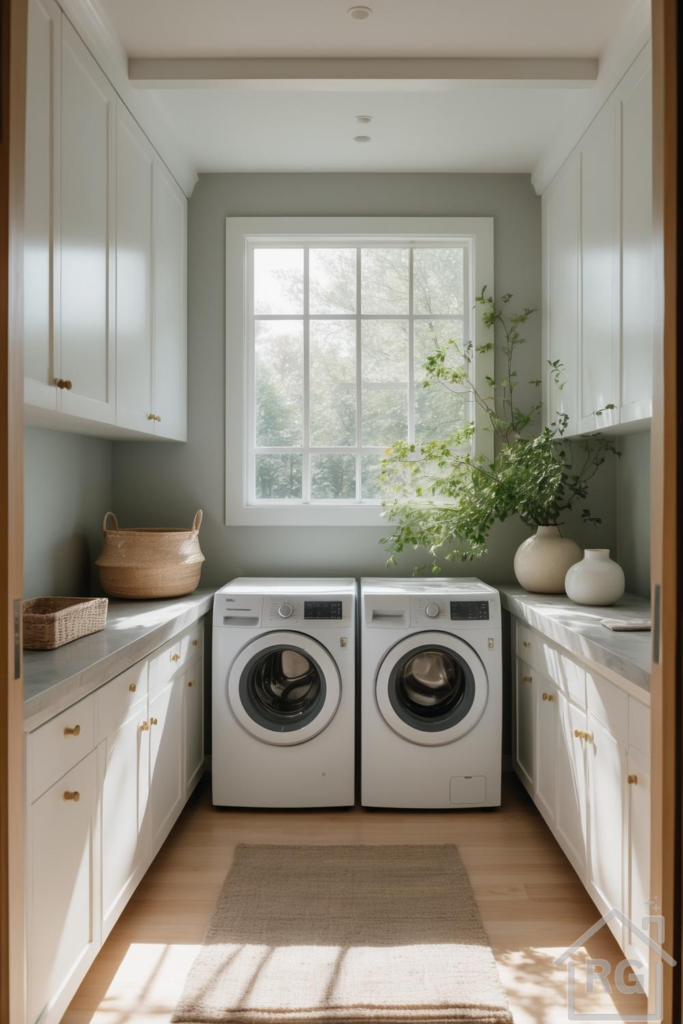
The laundry room, often overlooked in home design, holds immense potential to become a sanctuary of calm and efficiency. When designed with intention, this utilitarian space can transform your daily chores into a more mindful and pleasant experience. The Japandi style, a harmonious blend of Japanese minimalism and Scandinavian functionality, is perfectly suited for creating such an environment. This guide will walk you through how to achieve a serene Japandi laundry room, inspired by the beautifully balanced space shown, turning a mundane task into a moment of peace.
Understanding Japandi: The Soul of Simplicity and Warmth
Japandi design is more than just an aesthetic; it’s a philosophy. It marries the Japanese concept of “wabi-sabi” – finding beauty in imperfection and simplicity – with the Scandinavian “hygge” – a sense of coziness, comfort, and well-being. In a laundry room, this translates to clean lines, natural materials, a muted color palette, and an emphasis on functionality without sacrificing beauty. The goal is to create a space that is uncluttered, calming, and deeply connected to nature.
Deconstructing the Look: Key Elements of the Japandi Laundry Room
The pictured laundry room is a masterclass in Japandi design. Let’s break down its core components:
1. The Color Palette: A Symphony of Neutrals
The color scheme is foundational to the Japandi aesthetic. This room utilizes:
- Soft Sage Green: The walls are painted in a muted, earthy sage green. This color evokes a sense of calm and connection to nature, providing a gentle backdrop that isn’t stark white but still feels light and airy.
- Creamy Off-White: The shaker-style cabinets are a warm, creamy off-white. This choice avoids the clinical feel of bright white and adds a layer of softness and warmth, characteristic of hygge.
- Natural Wood Tones: Light wood flooring, possibly oak or maple, grounds the space. Its natural grain and warm hue introduce an organic element, essential in both Japanese and Scandinavian design.
- Earthy Beige: The woven rug introduces a subtle, earthy beige, adding texture and warmth underfoot while complementing the wood tones.
- Crisp White Accents: The washing machine, dryer, and window trim provide crisp white accents, ensuring the space feels clean and bright.
- Subtle Grey: The countertops introduce a cool, light grey, balancing the warmth of the wood and creamy whites.
This carefully curated palette creates a serene and cohesive environment, where each color works in harmony to promote tranquility.
2. Materials and Textures: Embracing Nature and Craftsmanship
Texture plays a vital role in adding depth and interest to a minimalist Japandi space. This room showcases:
- Painted Wood: The smooth, matte finish of the painted shaker cabinets offers a tactile quality that is both refined and understated.
- Woven Natural Fibers: The large woven basket on the countertop and the smaller one, along with the jute or sisal area rug, introduce rustic, natural textures. These elements bring warmth and a touch of wabi-sabi imperfection.
- Smooth Ceramic: The elegant, minimalist ceramic vases holding greenery add a touch of refined craftsmanship. Their smooth, cool surfaces contrast beautifully with the warmer, rougher textures.
- Matte Metal: The white appliances have a clean, matte finish, blending seamlessly rather than standing out as overly industrial. The small, warm brass knobs on the cabinetry add a subtle metallic accent, providing a touch of understated luxury.
- Polished Stone/Concrete-Look Countertops: The countertops appear to be a light grey polished stone or a high-quality concrete-look material. This provides a durable, sleek, and cool surface that complements the natural elements.
- Light Wood Flooring: The natural grain of the light wood floor adds visual texture and warmth.
- Glass: The large window panes allow light to flood in, contributing to the airy feel and reflecting the subtle textures within the room.
The interplay of these textures – smooth and rough, warm and cool – creates a rich sensory experience despite the minimalist approach.
3. Furniture and Fixtures: Functionality Meets Form
In Japandi design, every piece must be functional and beautiful.
- Shaker Cabinets: The choice of shaker-style cabinets is perfect for Japandi. Their clean lines, simple construction, and timeless appeal embody both Japanese simplicity and Scandinavian practicality. The ample storage they provide is crucial for maintaining an uncluttered space.
- Modern Appliances: The front-loading washing machine and dryer are sleek and modern, fitting well within the minimalist aesthetic. Their white color helps them blend with the cabinetry.
- Minimalist Hardware: Small, elegant brass knobs are used on the cabinetry. This choice adds a touch of warmth and sophistication without being overly ornate, aligning with the Japandi preference for subtle, high-quality details.
4. Light: The Unseen Designer
Natural light is paramount in Japandi design. The large, multi-paned window is a focal point, flooding the room with soft, diffused light. This not only makes the space feel larger and more inviting but also highlights the natural textures and subtle color variations.
For periods of low natural light, consider layered artificial lighting: recessed ceiling lights for general illumination and perhaps subtle under-cabinet lighting for task areas.
5. Decor and Accessories: Intentional and Nature-Inspired
Japandi decor is about quality over quantity.
- Greenery: The branches of fresh greenery in the ceramic vases are a key Japandi element, bringing life, a touch of color, and a direct connection to the outdoors. Choose simple, sculptural branches or understated plants.
- Woven Baskets: These are both decorative and functional, perfect for storing laundry supplies or sorting items. Their natural material and handmade quality add to the wabi-sabi charm.
- Ceramic Vases: Simple, handcrafted-looking ceramic pieces in neutral tones serve as beautiful, understated decorative objects.
- Area Rug: A natural fiber rug, like the beige one shown, adds warmth, texture, and comfort, defining the central space.
The key is to choose items that are either useful, beautiful, or ideally both, and that contribute to the overall sense of calm.
How to Achieve Your Own Japandi Laundry Oasis: A Step-by-Step Guide
Inspired? Here’s how you can bring Japandi serenity to your own laundry room:
Step 1: Declutter and Simplify
The first and most crucial step is to declutter. Japandi design thrives on minimalism. Remove anything that isn’t essential or doesn’t bring you joy. Think “less is more.” Invest in smart storage solutions to keep surfaces clear.
- Go through all your laundry supplies, linens, and miscellaneous items. Donate or discard what you no longer need.
- Organize remaining items into categories. Use clear or natural-material containers inside cabinets to maintain order.
Step 2: Choose Your Palette
Stick to a muted, nature-inspired color palette. Think soft, warm neutrals like those in the inspiration image:
- Walls: Consider shades of soft sage, muted greige, warm beige, or creamy off-white. These colors create a soothing backdrop.
- Cabinetry: Opt for light wood tones (like white oak or ash), painted off-whites, or subtle greys. The finish should ideally be matte or satin.
- Accents: Introduce subtle contrasts with darker neutrals like charcoal or deep brown in very small doses, or stick to varying shades within your chosen neutral family. Warm metallic accents like brass or bronze can add a touch of elegance.
Step 3: Select Natural Materials and Textures
Incorporate a variety of natural materials to add warmth and tactile interest:
- Wood: Use wood for flooring, shelving, or even a countertop accent. Light woods like oak, maple, or ash are ideal. Reclaimed wood can add character.
- Stone: Consider stone or stone-look materials (quartz, quartzite, concrete, or terrazzo) for countertops for durability and a natural feel.
- Natural Fibers: Introduce jute, sisal, linen, cotton, or wool through rugs, baskets, and window treatments (like simple linen blinds or bamboo shades).
- Ceramics: Choose handcrafted or minimalist ceramic pieces for storage containers, soap dispensers, or decor. Look for items with organic shapes and matte glazes.
Step 4: Invest in Quality, Functional Cabinetry and Appliances
Opt for clean-lined cabinetry, like Shaker style or flat-panel doors. Ensure you have enough storage to keep the space tidy. Consider floor-to-ceiling cabinets to maximize storage and maintain a streamlined look.
If replacing appliances, choose models with simple designs and energy-efficient features that blend well with the overall aesthetic. Integrated appliances can further enhance the minimalist look if your budget allows.
Step 5: Maximize Natural Light and Layer Artificial Lighting
If you have a window, keep window treatments minimal to maximize natural light – a simple roller blind, sheer linen curtain, or frosted glass works well. For artificial light, use a combination of:
- Ambient Lighting: Recessed lights or a simple, flush-mount ceiling fixture with a natural material shade (e.g., linen or paper).
- Task Lighting: Under-cabinet LED strips are very useful over countertops or folding areas.
Choose warm white bulbs (2700K-3000K) to enhance the cozy hygge feeling. Dimmers can help adjust the mood.
Step 6: Accessorize Mindfully
Select a few carefully chosen accessories that are both beautiful and functional:
- Plants and Greenery: Bring the outdoors in with simple plants like snake plants, pothos, or a few sculptural branches in a vase.
- Storage Solutions: Use attractive woven baskets, wooden boxes, or glass jars to store laundry essentials. Decant detergents and softeners into minimalist, matching dispensers to reduce visual clutter.
- Artwork (Optional): If you include art, choose simple, nature-inspired pieces, abstract line art, or black and white photography with a serene subject.
- Textiles: A soft, natural fiber rug or a neatly folded linen towel can add a touch of comfort and absorb sound.
Remember, every item should have a purpose or contribute to the serene atmosphere. Avoid overcrowding surfaces.
Step 7: Embrace Imperfection (Wabi-Sabi)
While aiming for a clean and organized space, don’t be afraid of slight imperfections that add character and authenticity. A slightly irregular handmade ceramic piece, the natural grain variations in wood, or a softly wrinkled linen cloth can enhance the wabi-sabi aspect of Japandi style, reminding us of the beauty in the natural and the handcrafted.
The Benefits of a Japandi Laundry Room
Transforming your laundry room into a Japandi-inspired space offers more than just aesthetic appeal:
- Reduced Stress: A calm, organized, and beautiful environment can make chores feel less burdensome and more like a mindful ritual.
- Increased Efficiency: A well-designed, uncluttered space makes it easier to find what you need and move through your tasks smoothly.
- Enhanced Well-being: Surrounding yourself with natural materials, soft light, and a serene atmosphere can positively impact your mood and overall sense of well-being.
- Timeless Appeal: Japandi design is not trend-driven; its focus on simplicity, quality craftsmanship, and natural beauty ensures it will look good and feel relevant for years to come.
- Connection to Nature: The emphasis on natural materials and greenery fosters a connection to the outdoors, which is known to have calming effects.
Conclusion: Your Sanctuary for a Mundane Task
Creating a Japandi laundry room is about transforming a purely functional area into a space that nurtures your well-being and simplifies your routine.
By focusing on a muted color palette, natural materials, clean lines, abundant light, and mindful organization, you can design a laundry room that is not only beautiful and efficient but also a true sanctuary of calm.
Embrace the principles of Japanese simplicity and Scandinavian warmth, and turn your laundry day into a more peaceful and even enjoyable ritual. Start with small changes, and gradually build your serene Japandi escape, one thoughtful element at a time.
